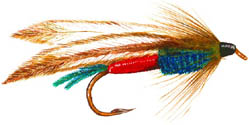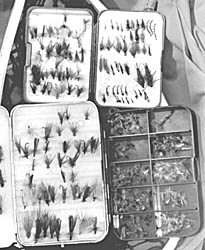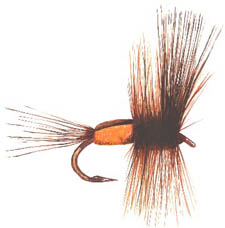Fly Boxes
by Clive Schaupmeyer
Fly anglers are not really a feuding bunch. But when certain fly-fishing topics are raised I am reminded of the western anecdote about "whisky and water are for fightin' over." Oh boy, nothing will start a heated discussion faster
than one fly angler making a statement about his or her preference of waders, reels, rods, lines and fly boxes. Ahhhh ... the gentle sport.
There are two questions about fly boxes that fly anglers wrestle with: what type to buy, and how to organize flies so they can be found. I've found a few fly boxes I like, but I will be working on fly organization until I go to the
big hatchery in the sky.
I prefer compartments for small dry flies and big flies like streamers. (The flies are stored loose in the pigeonholes.) I use boxes with flat, dense foam for most nymphs and ri
ppled foam for medium-sized dry flies like caddisflies. dense foam for most nymphs and ri
ppled foam for medium-sized dry flies like caddisflies.
Clear lids let you see what's inside - which is a bonus if you have two or more identical fly boxes. I use a neat two-sided box which has a compartment side for dry flies and a rippled, dense foam side for nymphs. A box like this i
s ideal for a beginning fly angler starting out with a modest collection of flies. However, two-sided fly boxes must have firm-holding closing devices for the two lids. I had a little incident with a two-sided box a few years ago.
Yes, you guessed it. I was rummaging through the upright compartments when I noticed a bunch of flotsam out of the corner of my eye. The bottom lid had opened and my flies were floating (and sinking) in the back eddies around my le
gs. I lost half a dozen flies or so. I still use this box (more carefully now) since it has large compartments for large nymphs on one side and streamers on the other.
Sooner or later most fly anglers accumulate a few fly boxes and wrestle with how they should be organized.  I currently have seven
fly boxes containing hundreds of flies and they are always in varying states of disorganization. Because of the complexity of fly patterns (species, sizes, dries, emergers, wets, streamers ...) there is no simple solution to fly arrangement. But it helps
if you can figure out some way that reduces on-stream searching and also allows you to confidently leave some boxes at home. For example, you might chase Green or Brown Drake mayflies for a few weeks each spring, and you'll likely keep these flies in one
box. But why carry them the rest of the year? I currently have seven
fly boxes containing hundreds of flies and they are always in varying states of disorganization. Because of the complexity of fly patterns (species, sizes, dries, emergers, wets, streamers ...) there is no simple solution to fly arrangement. But it helps
if you can figure out some way that reduces on-stream searching and also allows you to confidently leave some boxes at home. For example, you might chase Green or Brown Drake mayflies for a few weeks each spring, and you'll likely keep these flies in one
box. But why carry them the rest of the year?
A simple way to start organizing flies is to store dry flies together, nymphs together and streamers together. Within these general groupings there will need to be sub-group ba
sed on size, color or species. You may want or need a box exclusively for caddisflies. If the box is two-sided it could contain caddisfly dries on one side and pupae imitations on the reverse side. nymphs together and streamers together. Within these general groupings there will need to be sub-group ba
sed on size, color or species. You may want or need a box exclusively for caddisflies. If the box is two-sided it could contain caddisfly dries on one side and pupae imitations on the reverse side.
With a half dozen or more fly boxes stashed in a fly vest it's easy to waste time rummaging through them looking for one specific fly. A single day-use box is one way to reduce on-stream searching. That is, one fly box which contai
ns the majority of flies you'll likely need where you're fishing that day. Which flies are in the box in any one season or river will be based on personal experience or from information gathered from local fly shops.
My day-use box started for one specific river that I fish more often than any other. It is a shirt-pocket-sized, single-lid box with a rippled foam insert on the bottom and a flat foam sheet inside the lid. It holds around 50 or 60
flies that represent what I am most likely to need on that river at that time of year. Clearly not all flies I may need will fit, but it sure cuts down the time needed to search for flies. My day-use box is always in the same vest pocket and I know what'
s in it. If I'm fishing elsewhere for a few days, the contents of the day-use box evolve to accommodate the needs for the new stream.
Closing thought: A common mistake that people make when designing something completely foolproof is to underestimate the ingenuity of complete fools.
Return to Index
Copyright ©1998 Clive Schaupmeyer
Clive Schaupmeyer is an outdoor writer and photographer. He is the author of
The Essential Guide to Fly-Fishing,
a 288-page book for novice and intermediate fly anglers. His photo of a boy
fishing was judged the best outdoor picture of 1996 published by a member of
the Outdoor Writers of Canada. He fly-fishes for trout in Alberta's foothill
and mountain streams and for pike near his home in Brooks, Alberta.
Our Man In Canada Archives
|



